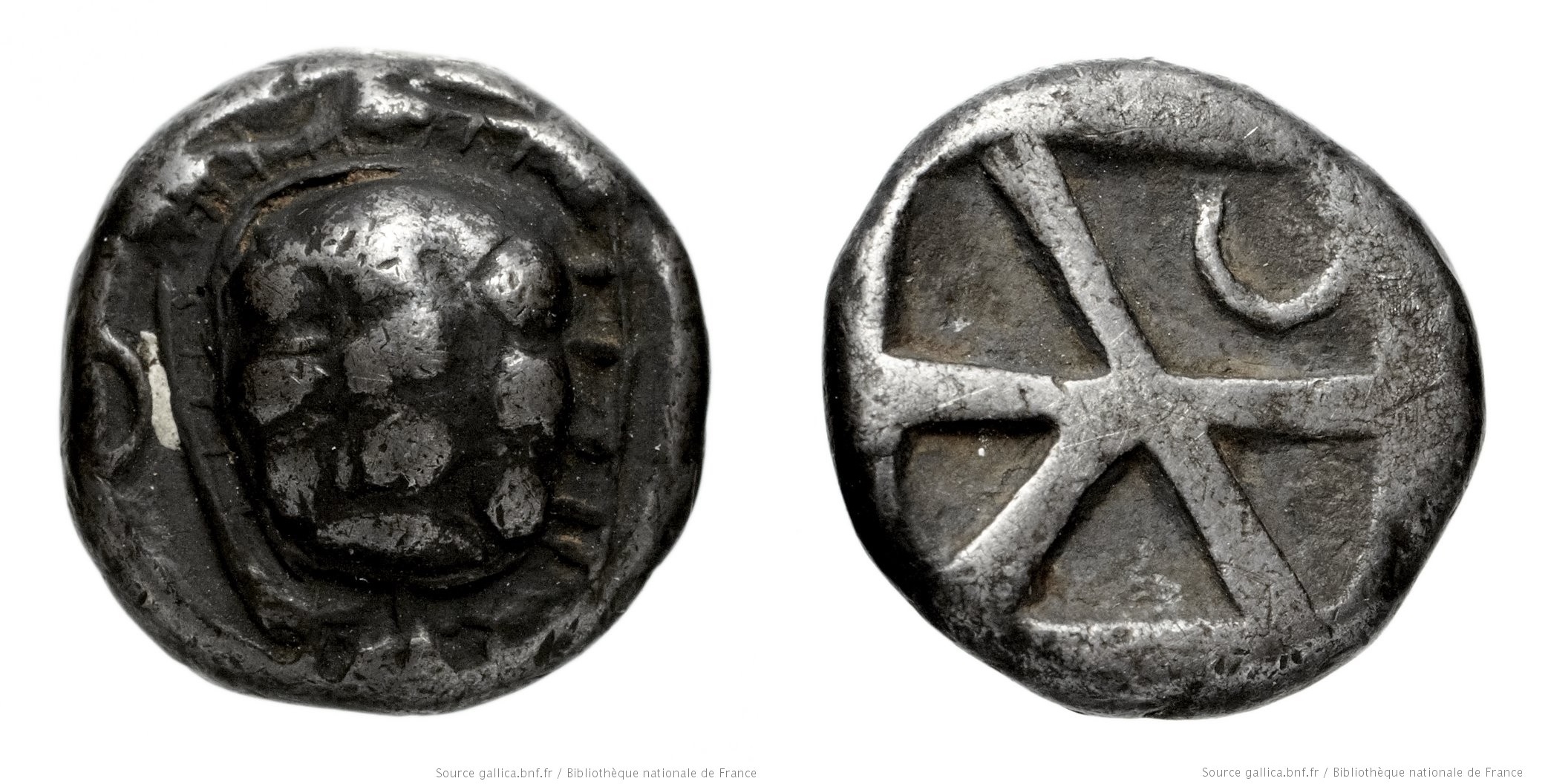S 747 - Cydonia, silver, hemidrachms (450-431 BCE)
From SILVER
450 BCE - 431 BC Silver 1,135 kg
Description
| ObverseInscription or printing placed on the obverse.: | Tortoise. In field, crescent. |
| ReverseInscription or printing placed on the reverse.: | Incuse square |
Mint and issuing power
| MintIdentifies the place of manufacture or issue of a numismatic object.: | Cydonia | Ancient regionAncient region.: | Crete | Modern countryModern country: Greece | AuthorityIdentifies the issuing power. The authority can be "pretended" when the name or the portrait of X is on the coin but he/she was not the issuing power. It can also be "uncertain" when there is no mention of X on the coin but he/she was the issuing power according to the historical sources: |
Chronology
| FromIdentifies the initial date in a range assigned in a numismatic context. | 450 BCE | toIdentifies the final date in a range assigned in a numismatic context.. | 431 BC | PeriodTime period of the numismatic object.: Classical 480-323 BC |
Physical description
| MetalThe physical material (usually metal) from which an object is made.: | Silver |
Median weightMedian of the weights of numismatic objects (in grams). in grams | 2.50 | DenominationTerm indicating the value of a numismatic object. Examples: tetradrachm, chalkous, denarius.: | hemidrachm |
StandardStandard.: |
Image

S 747 Cydonia hemidrachm 450-431.jpg [1]
References
| Die study referencePublication of the study: | Stefanakis 19971Stefanakis 1997, p. 43-47, no. 6-27 et 29-43 (hémidrachme, période I, groupe 2, types B-D). | ||
| Coin series referenceReference to coin series study: | |||
| Coin series web referenceCoin series web references: | |||
Obverse dies distribution
| FrequencyFrequency of specimen in distribution. ᵖ | Number of obversesNumber of obverse dies. ᵖ (o) | % (o) | Number of coinsNumber of coins. (n) | % (n) | Die nameName(s) of the die(s). |
| 1 | 9 | 50 | 9 | 16.36 | |
| 2 | 3 | 16.67 | 6 | 10.91 | |
| 3 | 1 | 5.56 | 3 | 5.45 | |
| 4 | 1 | 5.56 | 4 | 7.27 | |
| 5 | 1 | 5.56 | 5 | 9.09 | |
| 7 | 2 | 11.11 | 14 | 25.45 | |
| 14 | 1 | 5.56 | 14 | 25.45 | |
| Total | 18 of 18 | 100.02 | 55 of 55 | 99.98 |
Reverse dies distribution
no distribution is available
Quantification
| Number of obversesNumber of obverse dies. ᵖ (o) | 18 | Number of singletons (o1)The number of singleton coins. ᵖ | 9 |
| Number of reverse diesNumber of reverse dies. (r) | 37 | Number of coinsNumber of coins. (n) | 55 |
| Coins per obverse dieNumber of coins per obverse die. (n/o) | 3.06 | Coins per reverse dieNumber of coins per reverse die. (n/r) | 1.49 |
| Reverse per obverse ratioRatio of obverse dies divided by reverse dies. (r/o) | 2.06 | Percentage of singletons (o1)number of coins (n) divided by the number of singletons (o1) ᵖ | 50 % |
| Original number of dies (O) (Carter 1983 formula)The estimation of the number of coins according to Carter 1983 ᵖ | 22.7 | Coins struck if 20,000 as average productivity per dieCoins made if the average productivity for obverses (according to Carter) is 20,000. ᵖ | 454,000 |
| Original number of dies (O) (Esty 2011 formula)The estimation of the number of coins according to the singleton formula in Esty 2011 ᵖ (O) | 26.76 | Survival rate if 20,000 as average productivity per dieSurvival rate if average productivity is 20,000. ᵖ | 0.00012 |
| Coverage (o = % of O) (Esty 1984 formula)Esty 1984 - coverage (% of O) ᵖ (o = % of O) | 83.64% | Die productivity if survival rate 1/2,000Average productivity if survival rate is 1/2,000. ᵖ | 4,845.81 |
| Weight of silver (in kg) if 20,000 coins per die (O = Carter formula)Carter 1983 * Median weight * 20000 (*10 if gold or electrum) ᵖ | 1,135 kg <br /> 1,135 kg | Die productivity if survival rate 1/5,000Average productivity if survival rate is 1/5,000. ᵖ | 12,114.54 |
Remarks
References
- ^ Stefanakis, Manolis. I (1997), Studies in the coinages of Crete with particular reference to Kydonia [Unpublished doctoral dissertation], London University.